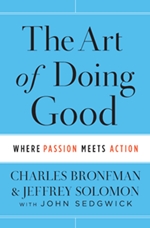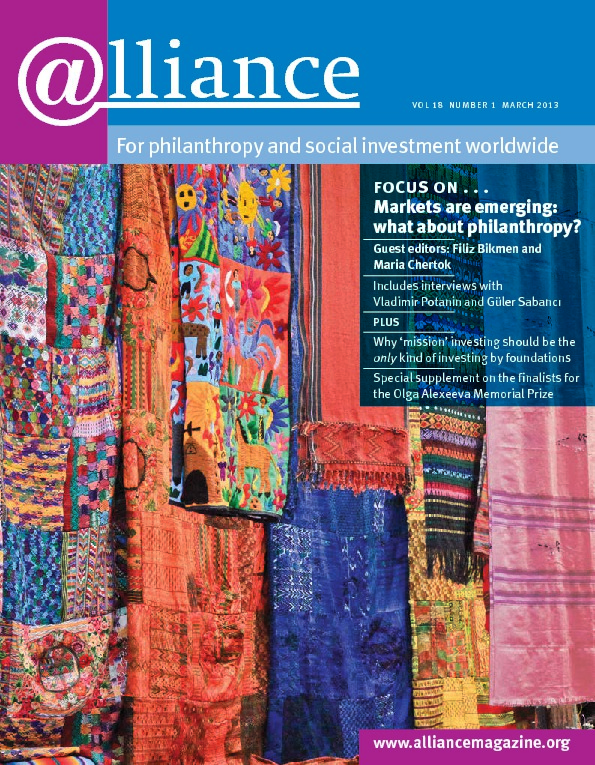 It must have been the ultimate flow experience: when Charles Bronfman and Jeffrey Solomon finished the book The Art of Giving: Where the soul meets a business plan, they started right away to work on The Art of Doing Good: Where passion meets action. The Art of Giving explored the principles of modern philanthropy. It was mainly based on Charles Bronfman’s experience as the chairman of Andrea and Charles Bronfman Philanthropies and Jeffrey Solomon’s work as the president of this group of foundations, from which they derived good practices of giving for (new) donors and philanthropy professionals.
It must have been the ultimate flow experience: when Charles Bronfman and Jeffrey Solomon finished the book The Art of Giving: Where the soul meets a business plan, they started right away to work on The Art of Doing Good: Where passion meets action. The Art of Giving explored the principles of modern philanthropy. It was mainly based on Charles Bronfman’s experience as the chairman of Andrea and Charles Bronfman Philanthropies and Jeffrey Solomon’s work as the president of this group of foundations, from which they derived good practices of giving for (new) donors and philanthropy professionals.
The Art of Doing Good is part two of the authors’ joyride – by the way, they do not deny this selfish motivation in writing the book. Their aim is to ‘engage the very many philanthropists with limited financial resources who passionately desire to change the world’. The book is based on in-depth interviews the authors conducted with 17 American ‘philanthropic activists’ and one Canadian. The portfolio of civic or social entrepreneurs includes Michael Brown, CEO and co-founder of City Year; Geoffrey Canada, president of the Harlem Children’s Zone; and Sara Green, founder of Art for Refugees in Transition. All of the 18 stories are inspiring. Bronfman and Solomon use the experience of the interviewees to explore three phases in developing a not-for profit venture: Sources of Inspiration, Bringing Your Idea to Life and Managing the Organization. In a fourth part, they provide resources for further reading or education.
The book is one of stories. Each of the 17 chapters tells one, two or more concrete stories from the field. The chapters focus on common themes that the authors derive from their interviews and their own experience. Most of the themes are not surprising – they are addressed in the classic not-for-profit management books – but the frankness and passion with which they come to life in this book are rare to find. One example is when Jay Feinberg, founder of the Gift of Life Bone Marrow Foundation, realizes that his life story and he as a person are part of the organization’s brand. The example shows how Feinberg struggles with the situation but finds ways to integrate his story into the brand, while at the same time ensuring that this does not threaten the sustainability of the organization.
In another story, Darell Hammond, founder of KaBOOM!, describes how a member of his management team tried to organize a ‘coup’ against him. The way he managed his board and talked to his staff and how this changed him as a person reads more like a business crime story than an example of how to manage a not-for profit venture.
These two illustrations show that the authors were able to discuss with their interviewees the downsides of doing good and the challenges of building a sustainable, effective not-for profit organization. Though the book is written in a very optimistic tone, it does not shy away from asking the hard questions when it comes to how people can change the world for the better.
The authors add to every case their analysis and they derive from this general principles for setting up and managing not-for-profit organizations. Time and again they also bring in their own experience as donors and philanthropic entrepreneurs – which shows how much the authors must enjoy their work, but which is a challenge for the reader. An example is the chapter ‘Staffing Up’, in which Bronfman and Solomon explore the challenges of finding the right people for a not-for-profit organization. The tone in this chapter suddenly shifts and the authors talk about how they selected staff for their foundations and other not-for-profits they had been involved with. These interventions are, to my mind, a distraction from the wealth of stories the 18 cases provide. Then again, they are also an expression of the authors’ passion for the sector.
The Art of Doing Good is a pragmatic and enjoyable introduction to the not-for-profit world. It will be interesting to see where the flow experience in writing this book will take the authors next.
Michael Alberg-Seberich is managing partner at Active Philanthropy. Email alberg-seberich@activephilanthropy.org
To order
http://www.josseybass.com
The Art of Doing Good: Where passion meets action
Charles Bronfman & Jeffrey Solomon with John Sedgwick Jossey-Bass $29.95
ISBN 978-1118264355





Comments (0)